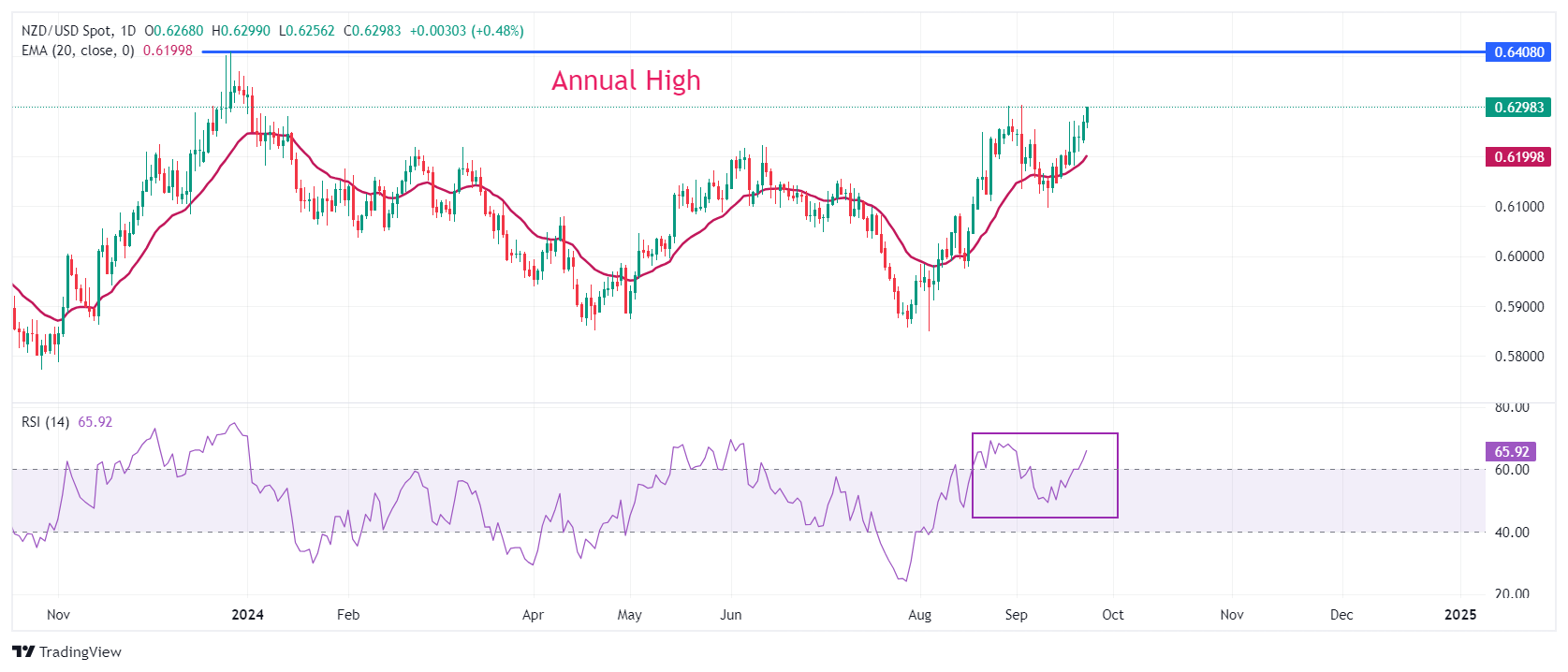- Analytics
- News and Tools
- Market News
- NZD/USD Price Forecast: Extends rally to near 0.6300 as China unveils massive stimulus
NZD/USD Price Forecast: Extends rally to near 0.6300 as China unveils massive stimulus
- NZD/USD surges to near 0.6300 as China announces a slew of monetary stimulus.
- The Fed is expected to opt a 50-bps interest rate cut in November.
- Investors await the US core PCE inflation data for August.
The NZD/USD pair rallies to near the key resistance of 0.6300 in Tuesday’s North American session. The Kiwi asset strengthens on the firm New Zealand Dollar (NZD), which is enjoying higher inflows after the announcement of China’s massive stimulus, with the aim to revive the economic prospects, uplifting household spending and real estate demand.
It is worth noting that New Zealand (NZ) is one of the leading trading partners of China, and the announcement of fresh stimulus will prompt Kiwi exports.
Meanwhile, the US Dollar (USD) remains under pressure amid growing discussions that the Federal Reserve (Fed) extend the policy-easing cycle aggressively. The US Dollar Index (DXY), which tracks the Greenback’s value against six major currencies, falls to near 100.75.
Going forward, investors will focus on commentaries from Fed officials and the United States (US) Personal Consumption Expenditure Price Index (PCE) for August, which will be published on Friday. The core PCE inflation is the Fed’s preferred inflation gauge, which is estimated to have grown at a faster pace of 2.7% from 2.6% in July.
NZD/USD extends its winning spell for the fifth trading day on Tuesday. The Kiwi asset approaches the annual high of 0.6400 formed on 26 December 2023. Upward-sloping 20-day Exponential Moving Average (EMA) near 0.6200 suggests that the near-term outlook is upbeat.
The 14-day Relative Strength Index (RSI) strives to sustain above 60.00. A bullish momentum would trigger if the oscillator manages to do so.
Further upside above the Year-To-Date (YTD) high of 0.6330 would drive the asset towards December 26 high of 0.6400, followed by 25 January 2023 low of 0.6450
In an alternate scenario, a downside move would appear if the asset decisively breaks July 17 high near 0.6100. This would push the asset lower to May 3 high at 0.6046 and the psychological support of 0.6000.
NZD/USD daily chart
New Zealand Dollar FAQs
The New Zealand Dollar (NZD), also known as the Kiwi, is a well-known traded currency among investors. Its value is broadly determined by the health of the New Zealand economy and the country’s central bank policy. Still, there are some unique particularities that also can make NZD move. The performance of the Chinese economy tends to move the Kiwi because China is New Zealand’s biggest trading partner. Bad news for the Chinese economy likely means less New Zealand exports to the country, hitting the economy and thus its currency. Another factor moving NZD is dairy prices as the dairy industry is New Zealand’s main export. High dairy prices boost export income, contributing positively to the economy and thus to the NZD.
The Reserve Bank of New Zealand (RBNZ) aims to achieve and maintain an inflation rate between 1% and 3% over the medium term, with a focus to keep it near the 2% mid-point. To this end, the bank sets an appropriate level of interest rates. When inflation is too high, the RBNZ will increase interest rates to cool the economy, but the move will also make bond yields higher, increasing investors’ appeal to invest in the country and thus boosting NZD. On the contrary, lower interest rates tend to weaken NZD. The so-called rate differential, or how rates in New Zealand are or are expected to be compared to the ones set by the US Federal Reserve, can also play a key role in moving the NZD/USD pair.
Macroeconomic data releases in New Zealand are key to assess the state of the economy and can impact the New Zealand Dollar’s (NZD) valuation. A strong economy, based on high economic growth, low unemployment and high confidence is good for NZD. High economic growth attracts foreign investment and may encourage the Reserve Bank of New Zealand to increase interest rates, if this economic strength comes together with elevated inflation. Conversely, if economic data is weak, NZD is likely to depreciate.
The New Zealand Dollar (NZD) tends to strengthen during risk-on periods, or when investors perceive that broader market risks are low and are optimistic about growth. This tends to lead to a more favorable outlook for commodities and so-called ‘commodity currencies’ such as the Kiwi. Conversely, NZD tends to weaken at times of market turbulence or economic uncertainty as investors tend to sell higher-risk assets and flee to the more-stable safe havens.
© 2000-2025. All rights reserved.
This site is managed by Teletrade D.J. LLC 2351 LLC 2022 (Euro House, Richmond Hill Road, Kingstown, VC0100, St. Vincent and the Grenadines).
The information on this website is for informational purposes only and does not constitute any investment advice.
The company does not serve or provide services to customers who are residents of the US, Canada, Iran, The Democratic People's Republic of Korea, Yemen and FATF blacklisted countries.
Making transactions on financial markets with marginal financial instruments opens up wide possibilities and allows investors who are willing to take risks to earn high profits, carrying a potentially high risk of losses at the same time. Therefore you should responsibly approach the issue of choosing the appropriate investment strategy, taking the available resources into account, before starting trading.
Use of the information: full or partial use of materials from this website must always be referenced to TeleTrade as the source of information. Use of the materials on the Internet must be accompanied by a hyperlink to teletrade.org. Automatic import of materials and information from this website is prohibited.
Please contact our PR department if you have any questions or need assistance at pr@teletrade.global.
















